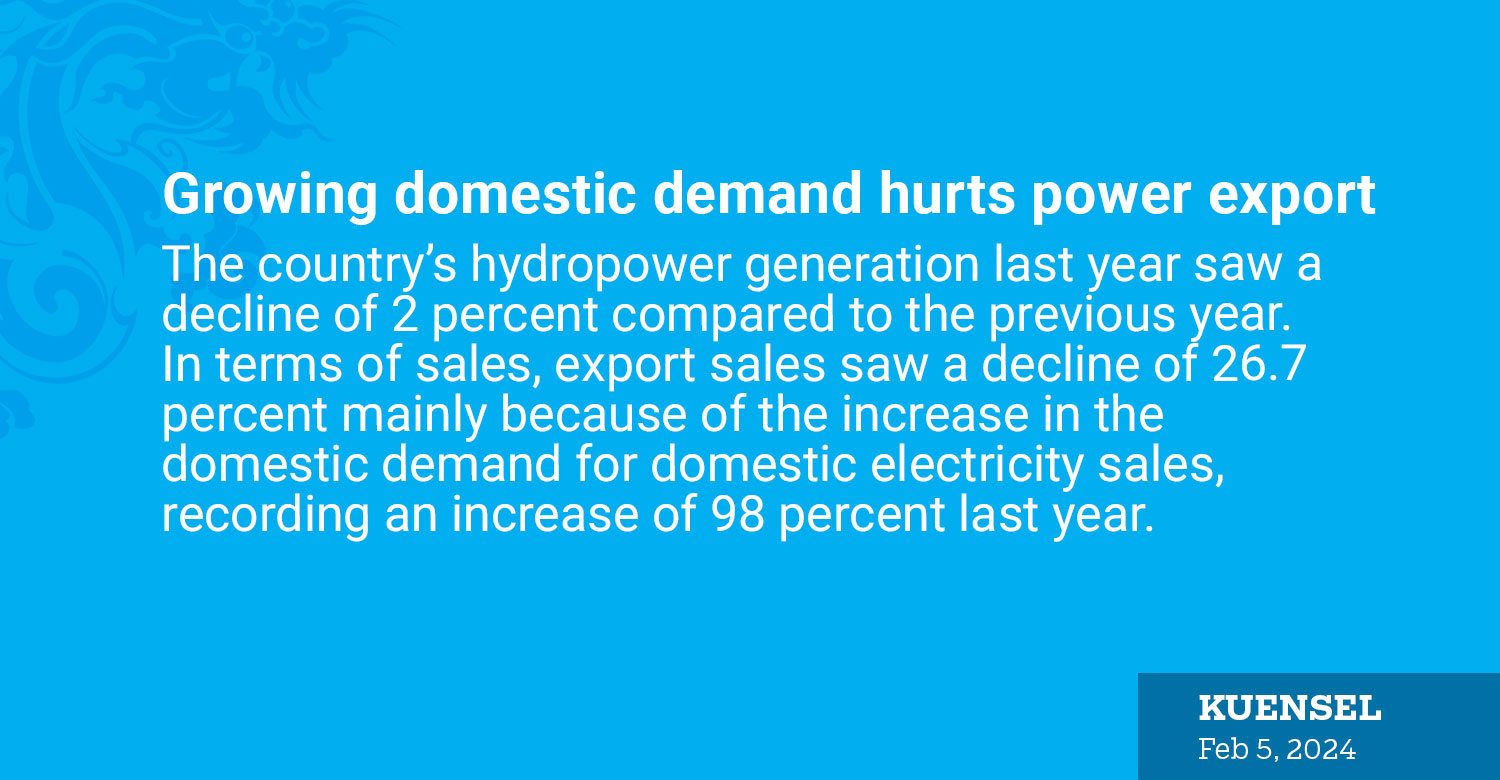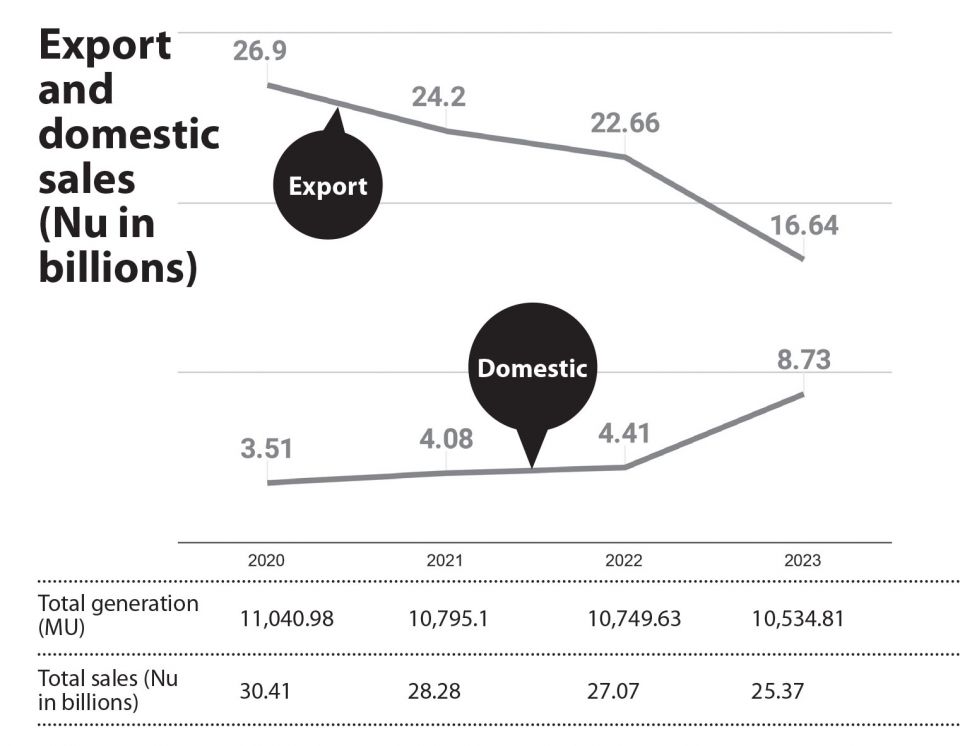
… power generation falls 2 percent in 2023
The country’s hydropower generation last year saw a decline of 2 percent compared to the previous year.
In terms of sales, export sales saw a decline of 26.7 percent mainly because of the increase in the domestic demand for domestic electricity sales, recording an increase of 98 percent last year.
The overall generation was recorded at 10, 534.81 million units (MU) of electricity last year, a decrease of 218.09 MU from 10, 749.63MU in 2022, according to the figures from the Druk Green Power Corporation (DGPC).
The electricity sales for both export and domestic also saw a decline from Nu 25.37 billion last year from Nu 27.07 billion in 2022.

The plants under DGPC—Tala, Kurichhu, Chhukha, and Basochhu generated 6,945.61MU, and the Mangdechhu hydropower plant (MHP) and Dagachhu projects added 3,145.05MU and 444.15MU respectively.
DGPC’s Managing Director, Dasho Chhewang Rinzin said that despite the shutdown of the Tala hydropower plant for repair and maintenance from January to March 2022, the generation from DGPC’s plants last year decreased by 275.58 MU mainly because of poor hydrology.
For the MHP, he added that generation saw an increase by 60.09 MU last year compared to the previous year although there was a major outage with Unit III, which resulted in less generation in 2022. “Otherwise, hydrology in 2022 was better than 2023.”
At the same time, generation from Dagachhu projects saw a decrease of 2.6 MU compared to 2022.
Considering that the export tariffs are higher than the domestic generation tariffs, there is an overall decreasing trend in revenues accrued to DGPC and the power plants.
In figures, the export sales in 2022 reported at Nu 22.6 billion saw a decrease to Nu 16.64 billion. However, the domestic sales increased to Nu 8.73 billion in 2023 from Nu 4.41 billion last year.
DGPC’s power plants saw export earnings worth Nu 5.38 billion and Nu 6.2 billion from domestic sales.
MHP’s export revenue was Nu 10.03 billion domestic sales were Nu 2.53 billion, Dagachhu’s export revenue was Nu 1.22 billion and domestic sales at Nu 11.76 million.
For the 2023-2024 lean season, the projected demand is 1,517 MU and the projected landed tariff for this season is expected to be in the range of Nu 4.12 per kilowatt-hour (kWh) to Nu 6.48 per kWh.
In December last year, Bhutan purchased 254.82 gigawatt hours of electricity. It is expected that electricity imports will increase in the fiscal year 2023-24 because of the increasing trend of domestic demand compared to the past.
From October 11 to November 16 last year, Basochhu exported 40.27 MU of electricity worth Nu 230.94 million after the deduction of fees, charges, and trading margin at the tariff rate of Nu 5.73 per kWh.
Moving forward
Bhutan’s energy demand could grow by over 400 percent by 2030 if the country’s energy demand peaks, the Department of Hydropower Systems forecasts.
To meet the growing domestic demand and to ensure Bhutan’s energy security, the power sector is considering prioritising reservoir and pumped storage projects in future, a move away from the current run-of-rivers projects, according to the DGPC.
There is also an emphasis on diversifying investments into other renewables, especially solar in the short term. “Solar hydro hybrids are a viable solution for energy security with the falling costs of solar,” it added.
The Department of Energy targets to generate 500 megawatts of electricity from the share of renewable energy in the next five years.
On January 18 this year, one of the units of the Nikachhu hydropower plants was connected to the national grid of two units with 59 megawatts each. The project is expected to generate a revenue of Nu 1.6 billion annually.
At the same time, the start of Punatsangchhu-II plant by the end of this year could contribute to Bhutan’s economy.
Hydropower, a key contributor to growth, was estimated to experience a temporary decline of negative 0.1 percent in 2023 before rebounding to 8.9 percent in 2024, driven by the commissioning of Punatsangchhu-II and Nikachhu hydro-projects, according to the Royal Monetary Authority.
Several small hydropower projects, which are presently under construction, are expected to be commissioned between 2024 and 2025.
According to the DGPC, the generation pattern is mainly dependent on the hydrology and forecasts are that, at least in the foreseeable future, there will not be many changes in the inflow patterns.
However, with climate change, it is projected that in the long term, the winters may be drier while the monsoons will be more intense and shorter.












